Ultimate Frisbee Training Benchmarks - How do Ultimate Frisbee Athletes Prepare for the Season?
The Ultimate Athlete Project surveyed1 over 300 ultimate players to learn about their training habits as they prepare for US Club nationals. This data provides useful benchmarks for players as they're trying to get to the next level of play.
How do you stack up? Are you doing the things you need to do in order to play at the level you want to play at?
Let's find out!
How far in advance do players start getting ready for their club season?
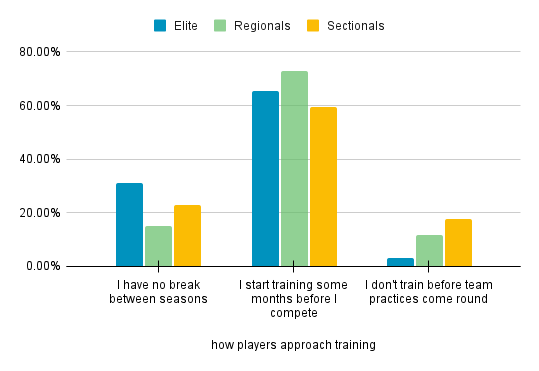
At all levels, most players take some kind of break between seasons - more on that below - and most start training before their competitive season. At Elite2 levels, about a third report playing straight through because of other commitments, and everyone does some training before their next season.
Focusing on just those who take a break and then start training before they compete, we can look at when they start their training...
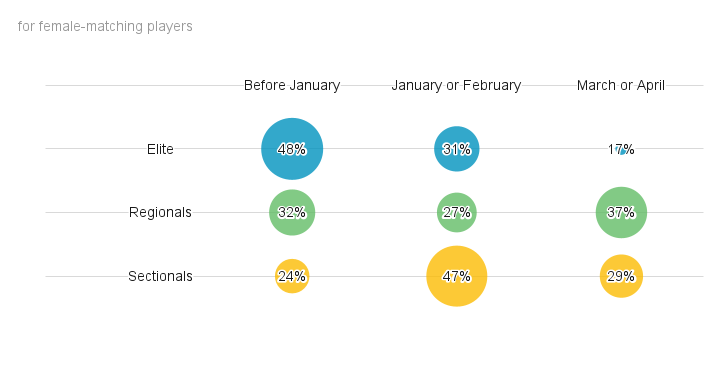
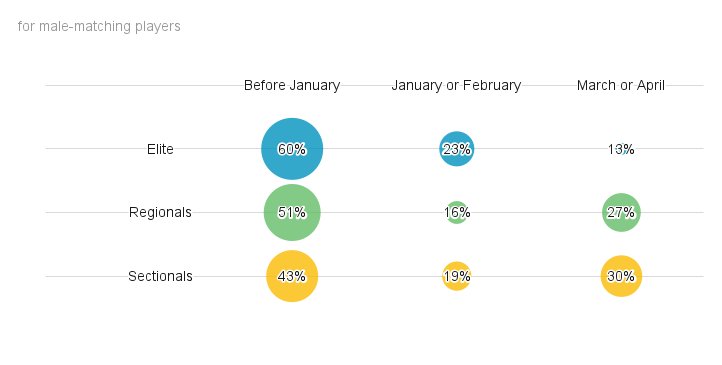
In general, Elite level players start getting ready for club season before January. With Nationals in October, that leaves a window of maybe 4-6 weeks downtime before the next training cycle starts up.
For female-matching players at Regionals level, the start window is fairly evenly spread, whilst those at Sectionals level primarily start in Jan or Feb.
For male-matching players, there is a clear division, between those reporting as starting before January, and those starting in March or April.
So, with Nationals in October, that leaves a window of maybe 4-6 weeks downtime before winding up for those starting before January, and for others, it's a longer window. Here's what folks tell us they do in their downtime. Is you favourite activity on there? What would you add?
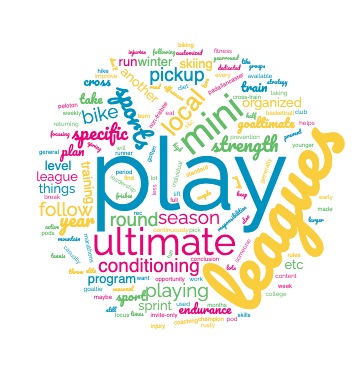
Throwing Habits
It should be no surprise that players at the elite level of club spend more time throwing than those at the regionals or sectionals level.
In general, throwing hours increase about one day per week as you go from sectionals to regionals to nationals levels of play.
If you're looking to play nationals level ultimate, expect to put in more hours of throwing to acquire and maintain the throwing skills you'll need.

How do players practice throwing?
Here are a few responses from the survey that give an idea of what players are doing for their throwing practice.
- "I will usually throw for at least 20 minutes a day. If I don’t have a partner I will do a 70 throw at a target, throw hucks at a target (call it like 20 backhands and 20 forehands), and sometimes will practice throws specific to my teams reset system."
- "Throw short and far, and always throw like there is a mark on me"
- "usually pick a sticking point of a particular throw and rep it while tweaking to find what works and feels best"
- "make throwing intentional, visualize breaking the mark or throwing hucks or something productive"
In our UAP Premium program we take a science based approach to throwing practice. You can learn a bit more about these concepts in How to Make Your Throwing Practice Count and Quick Improvement in Throwing.
Skills and Game IQ Work
Very few players at the Elite level ignore skills and Game IQ work. The majority spend at least one day per week on some sort of skills or game IQ activity

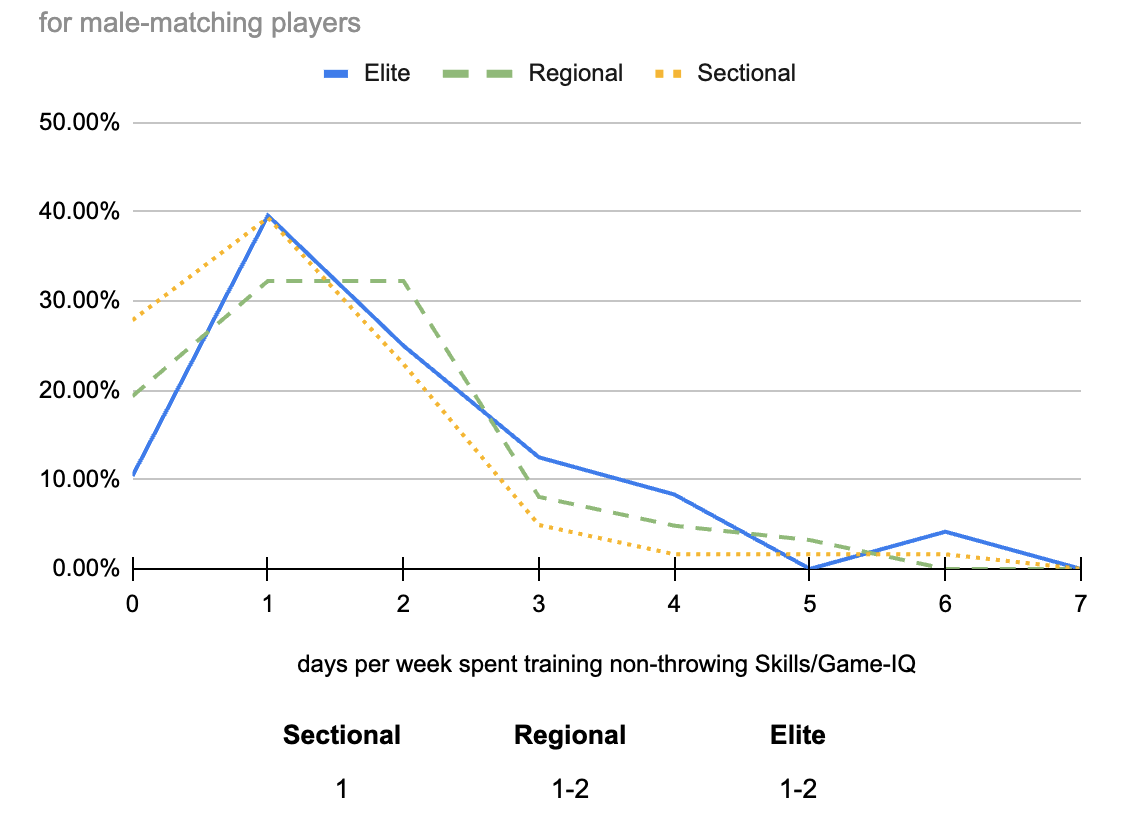
How do players work on Skills and Game IQ?
- “Watch film, pause, slow down and visualize”
- “Watching videos and playing with experienced people”
- “I usually try and play PADA league year round to get reps in and learn from more experienced players/play a different way then my club team. I occasionally watch high level club or AUDL games.”
- “Reading articles, watching film, practice planning, talking to other leaders, reviewing rules”
- “A lot of visualization about different scenarios; discussion of plays posted on Reddit or interesting strategy with significant other”
Physical Preparation
To play at an elite level, you need a high degree of athleticism.
As expected, the amount of time spent on physical preparation increases as you get to higher levels of play.

Surprisingly, only about 40% of ultimate frisbee athletes use an athletic performance program. If you are on an athletic performance program (like the UAP Strength and Conditioning program) this means you will have an advantage over those who are not using their time as efficiently.
What are players doing for their physical preparation?
- “Weight lifting, playing in leagues, jumping drills. Stretching before and after play!”
- “I do typical push, pull, legs, cardio”
- “Gym/Track Training”
- “I do UAP and some pick up soccer for crosstraining”
- “Focused lifting on a plan early in the beginning of training which transitions to a blend of running/sprints and lifting”
- “I rock climb and play ultimate. No strength plan”
In case you really like data
For the data-heads amongst you, Oliver has some information:
If you’re interested in looking into the data yourself, you can access and download a copy here, subject to the usage details in the readme. If you find anything you think is interesting, and/or want to talk about how we might increase coverage with our next state-of-the-union survey, then please email Oliver ([email protected]) as he enjoyed playing around with this and would like to do it again!
1. We sampled US-based players. We defined three target levels: players who teams played Sectionals but didn't progress, players who teams reached Regionals, and players who teams reached Nationals. We collected 309 responses, with roughly 50 of each gender and each 'level', and these responses are roughly evenly spread across the three divisions (Mixed, Women's, Men).
2. We've defined "Elite" as anyone playing on a team that attends USAU Club Nationals
3. Female-matching and male-matching players experience many things differently in life, and this has impacts on the way female-matching players train. If we have presented a single graph, it means we did not find significant differences between the gender in the data we collected. FYI We did also collect information on what division the players usually compete in, but are still examining that; in general the differences are not significant given the sample size.

